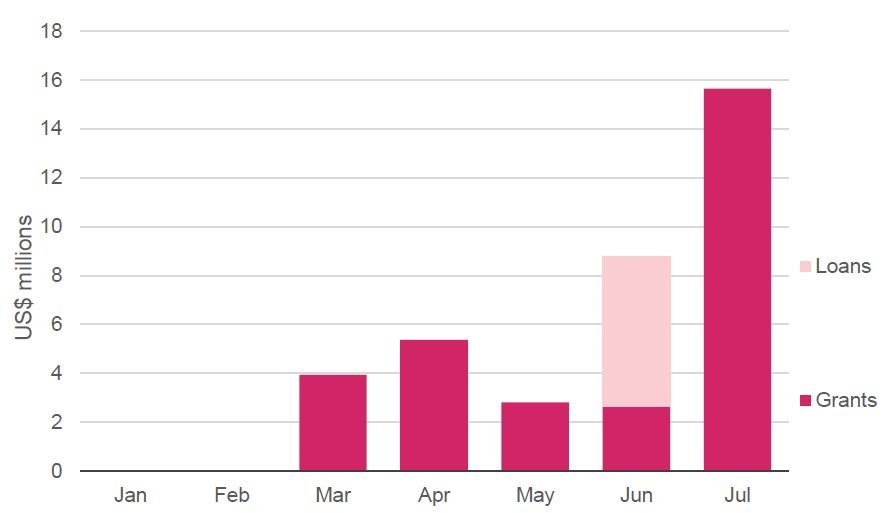Supporting longer term development in crises at the nexus: Lessons from Cameroon: Chapter 2
Crisis context
DownloadsThree separate crises, different opportunities and challenges
Cameroon is the largest economy of the Central African Economic and Monetary Community [1] and a lower middle-income country that was, until 2014, relatively stable in comparison to its neighbours. However, the country now faces three simultaneous humanitarian crises affecting eight of Cameroon’s 10 regions (Figure 1). The escalation of the separatist conflict in the Northwest and Southwest and the rapidly deteriorating security situation since 2017 has resulted in growing internal displacement and protection risks. In addition, the Far North has been impacted by the prolonged regional Boko Haram conflict, which is further exacerbated by climatic vulnerability. Finally, the eastern regions face pressures related to the protracted displacement and vulnerability of refugees from the Central African Republic (CAR). As a result of these dynamics, the number of internally displaced people (IDPs) now outpaces the number of refugees, and the population that is food insecure has grown in recent years. The map shows a higher number of IDPs (950,263) than refugees (406,277 from CAR, Nigeria and urban refugees and asylum seekers) in December 2019. [2] The number of people experiencing crisis levels of food insecurity (Integrated Food Security Phase Classification (IPC) Phase 3 or above) rose to 1.4 million during October – December 2019. [3]
Figure 1: Levels of food insecurity, poverty and displacement by region
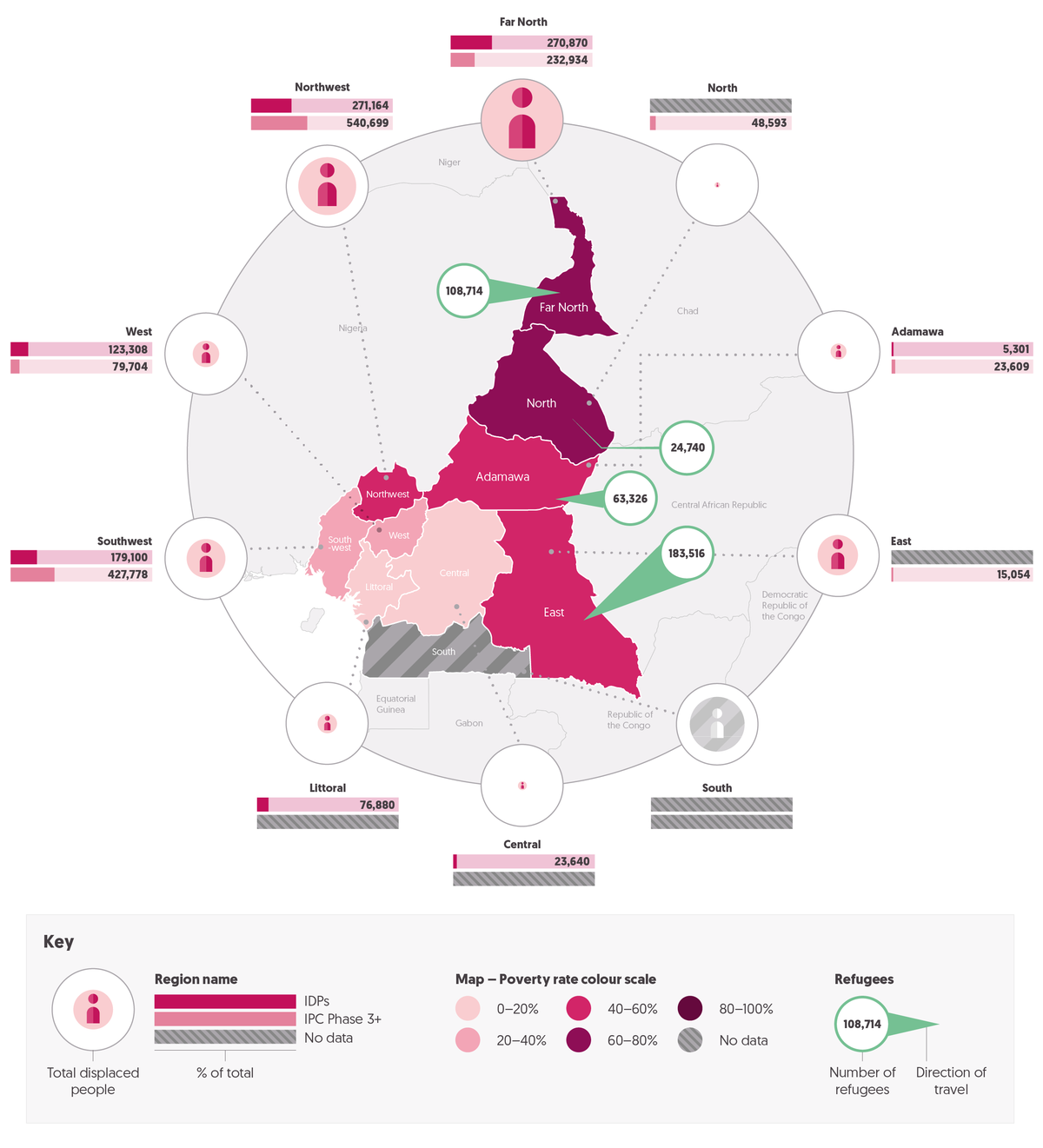
Cameroon now faces three simultaneous humanitarian crises affecting eight of Cameroon’s ten regions. The escalation of the separatist conflict in the Northwest and Southwest and the rapidly deteriorating security situation since 2017 has resulted in growing internal displacement and protection risks.
Source: Development Initiatives based on UNHCR, World Bank PovcalNet and Demographic and Health Surveys and Food Security Information Network.
Notes: UNHCR figures for refugees and IDPs are as of December 2019. Total displaced people do not include returnees. Cameroon also has a small population of asylum seekers and urban refugees that are not included in these figures. IPC Phase 3+ as of October 2019 includes people experiencing acute food and livelihood crisis (IPC 3), humanitarian emergencies (IPC 4) or famine and humanitarian catastrophe (IPC 5). No region in Cameroon is in IPC Phase 5. P20 figures from 2018. *P20 data for the Southwest region is representative of urban areas only and is not strictly comparable with P20 levels in the other regions. P20 = the poorest 20% of people.
CAR refugee crisis, East and Adamawa regions: Protracted displacement
While refugees from CAR have moved into Cameroon since 2004, the situation escalated in 2014 with a large and sudden wave of arrivals into east Cameroon following an escalation in violence in CAR. This triggered a humanitarian response in eastern regions, which are today home to over 270,000 refugees from CAR. [4] Although there are agreements in place to facilitate the voluntary return of CAR refugees, and approximately 6,000 refugees plan to return to CAR, there is limited prospect of return for the vast majority of refugees due to continued insecurity in CAR.
While there continue to be some new arrivals, the emergency phase has passed and the needs of refugees require structural and longer term responses. More than 98% of CAR refugees are estimated to be living below the national poverty line and struggle to meet their basic needs. [5] According to the Refugee Influx Emergency Vulnerability Assessment, combining food insecurity and poverty, 87% of CAR refugees (over 200,000) are highly vulnerable. [6] Tensions between refugees and host populations have, according to some interviewees, risen with increased pressure on natural resources and basic social services, exacerbating pre-existing vulnerabilities, particularly among agro-pastoral communities. Access to basic services is limited for both refugees and host communities.
Lake Chad Basin crisis and Boko Haram insurgency, North and Far North regions: Marginalisation, cross-border conflict and displacement
The northern regions of Cameroon are affected by the decade-long conflict involving Boko Haram in the Lake Chad Basin, which has displaced 2.4 million people and affects some 17 million people in Nigeria, Cameroon, Chad and Niger. Following Nigeria, Cameroon is the second most affected country. [7] This crisis has multiple, interlinked causes. These revolve around the drying out of Lake Chad, once one of Africa’s largest freshwater bodies and a source of livelihoods for millions of people, due to climate change and overuse. Declining resources coupled with a growing population resulted in migration and increased conflicts over pasture and water, especially between herders and farmers. The crisis escalated with the emergence of the militant Islamist Boko Haram insurgency, which the US officially designated a terrorist organisation in 2013. It has been further reinforced by the structural and longstanding under-development of the region; a broken social contract manifested in lawlessness; the lack of a consistent institutional and security response to the Boko Haram insurgency; and a deepening climate crisis, with recurrent flooding and drought. [8]
The North and Far North were already Cameroon’s poorest regions before the Boko Haram insurgency. 74.3% of the four million inhabitants in the Far North live below the poverty line, compared with a national average of 37.5%. [9] Access to essential social services remains extremely limited. Boko Haram’s attacks since 2014 have forcibly displaced civilians within Cameroon and across the Nigerian–Cameroon border. The Far North is the region most affected by Boko Haram, with ongoing attacks and suicide bombings, while the North is impacted by both the Boko Haram insurgency and the crisis in CAR.
In 2014, the international community mobilised a humanitarian response to the IDP and refugee crisis in the Far North. [10] Conflict and displacement in the Far North is ongoing, with 1 million people in need of urgent assistance and 480,000 people displaced (including returnees) in 2020. [11] However, there are also areas of stability, [12] with various recovery and development programmes in place.
Sociopolitical crisis, English-speaking Southwest and Northwest regions: Active domestic conflict and internal displacement
Since the 1990s, the two mainly English-speaking regions of Cameroon – the Northwest and Southwest – have been engaged in ongoing resistance aimed at gaining greater legal and political autonomy and addressing the region’s perceived marginalisation. Protests in 2016 escalated into an armed conflict between the government’s security forces and English-speaking separatists. The situation then rapidly deteriorated, with grave human rights violations on both sides. Almost 680,000 Cameroonians are now internally displaced due to the crisis in the English-speaking regions. [13]
The government officially recognised the crisis in the English-speaking regions at the end of 2018 and organised the Major National Dialogue aimed at resolving the conflict in September/October 2019. However, the English-speaking separatists boycotted the dialogue. The main recommendation emerging from this process was to accelerate decentralisation and grant the English-speaking regions special status.
Humanitarian resources were first allocated to the English-speaking regions in 2019, when the government officially recognised the crisis, and have since been scaled up. However, international agencies interviewed claim that humanitarian needs in the English-speaking regions are greater than reported by the government and there has not yet been a comprehensive needs assessment. Key development actors, including the World Bank and United Nations Development Programme (UNDP), are also considering ways to support longer term recovery and development.
Poverty, inequality and government policy
Crises exacerbated by inequality and centralisation
Uneven economic development, which has marginalised rural areas and the northern and eastern regions, is a major structural driver of Cameroon’s three crises. Political and economic power is highly centralised. Although gross domestic product (GDP) has grown, aggregate national poverty levels have remained static over the last decade (with 39.9% of the population living in poverty [14] in 2007 and 39.1% in 2019). Economic growth and development have largely benefited the central and southern regions, with the poorest people heavily concentrated in the conflict-affected North and Far North regions (Figure 2). [15] The number of people living in poverty more than doubled between 2001 and 2014 in the North and Far North. [16] The government’s own data shows a similar trend, but also shows higher poverty levels in the Northwest and disparities between rural and urban areas. [17]
Figure 2: Proportion of the poorest 20% of people globally, by region of Cameroon, 2000–2014
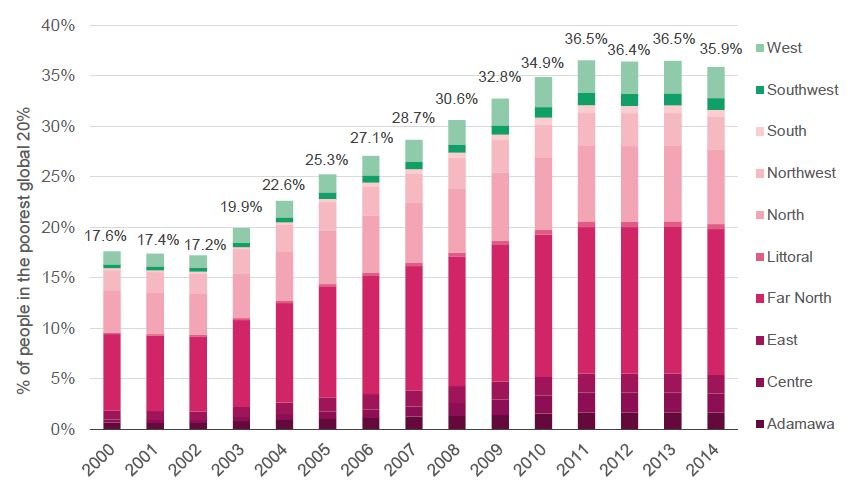
Economic growth and development have largely benefited the central and southern regions, with the poorest people heavily concentrated in the conflict-affected North and Far North regions.
Source: Development Initiatives based on UNICEF Multiple Indicator Cluster Surveys (MICS).
The primary focus of the government’s development policy and strategy has been on economic development, with minimal attention to reducing disparities or targeting poorer regions and groups. Vision 2035, Cameroon’s national development strategy and plan for 2010–2020, is largely focused on making the country an emerging economy by 2035 ( Appendix 2 ). [18] The northern and eastern regions have long experienced low state presence and public investments, especially in social sectors, as well as poor public administration and implementation capacities, poor governance and community participation. [19] Only around 1% of GDP is allocated to municipalities, and their expenditures represent less than 5.56% of national public expenditures. [20] Resource and budget allocations are distributed through patronage systems, rather than according to local needs and priorities.
The new national development strategy for 2020−2030 (in support of Vision 2035; currently pending approval by the President [21] ) according to UN representatives reportedly offers more opportunities to address inequalities through a pro-poor approach, support to social sectors and emphasis on the needs of refugees and crisis-affected people ( Appendix 2 ). However, the strategy is not publicly available and interviewees report that the consultation process has been relatively narrow.
Low domestic investment in human development
Relatively low levels of investment in health, education and social protection in Cameroon exacerbate marginalisation.
- Health: Cameroon’s proportional health spending is among the lowest in the world [22] and has disproportionally benefited large tertiary hospitals at the expense of more cost-effective primary care. [23] Data on child mortality reveals a similar trend in terms of disparities between regions. [24]
- Social protection: Social protection spending is among the lowest in sub-Saharan Africa at less than 0.1% of GDP, and a large share of the social protection budget goes to civil servants’ pension schemes, with limited labour market programmes at the expense of poor and vulnerable households. [25]
- Education: Education spending has also been relatively low compared with other countries in Africa, and poorer regions have systematically received less. For example, students in the North Region receive 2.2 times less spending than students in the Littoral Region. Data on school attendance reveals a significantly worse outcome for Adamawa, the North and the Far North compared with other regions.
Decentralisation and investment in poorer, crisis-affected regions
Public discontent with the government as a result of marginalisation and exclusion, especially in the northern, eastern and English-speaking regions, [26] has led to calls for decentralisation and greater regional autonomy. In 1996, Cameroon adopted a new constitution that granted greater autonomy to the regions, but few provisions were initially implemented. Basic competencies and resources were transferred to local councils only in 2010, and in December 2016 they were given full power to carry out their constitutionally mandated 63 functions. In recent years, the government has made commitments to accelerate this process and taken steps to strengthen local government capacity, mainly in response to demands from English-speaking regions (Box 2). However, despite the significant expansion of local government responsibilities, the central government has yet to increase fiscal transfers to local government. Cameroon has a highly centralised system for managing its domestic budget, with 87% of public expenditure managed at the central level as of 2015. [27] The weak capacity of local government and municipalities to manage funds and deliver services is a key reason for this and makes it challenging for donors to channel funding to the regions.
A further challenge is that Cameroon’s spending on health, education and other public services is low compared with other sub-Saharan African countries and is biased towards the more developed regions rather than reflecting the needs of local populations. For example, health spending is driven by the presence of health facilities rather than needs, such that the northern and eastern regions receive less funding per capita compared with other regions despite their higher rate of under-five mortality. [28] A similar pattern exists in the education sector, with the lowest levels of spending per student in the areas with greatest need.
Box 2
Recent decentralisation efforts
In 2018 the Ministry of Decentralisation and Local Development was established to modernise local councils. It is developing a national decentralisation strategy to reduce development disparities between municipalities. A local development index of needs is expected to be part of this strategy to improve national planning. According to the ministerial budget data for 2017 to 2020 (Figure 3), this ministry saw a large increase in funding in 2019 to build the capacity of local governments to manage funds and deliver services. However, the central government has not increased the proportion of the central budget allocated to local government, thereby limiting regional and local autonomy in service delivery.
Nonetheless, local governments can engage in revenue generation, partly facilitated by the Special Fund for Inter-municipal Equipment and Intervention. The fund collects certain council revenues and disburses them either as a block grant to regional authorities (74% of total in 2018) or through a local development fund (26% of total in 2018). [29]
Following the Major National Dialogue aimed at resolving the crisis in the English-speaking regions, parliament enacted a new law (the General Code of Regional and Local Authorities) in December 2019, granting the Northwest and Southwest regions “a special status based on their language, specificity and historical heritage”. The law commits to channel an increased proportion of the central budget to municipalities. [30]
Figure 3: Government expenditure by ministry, 2017–2020
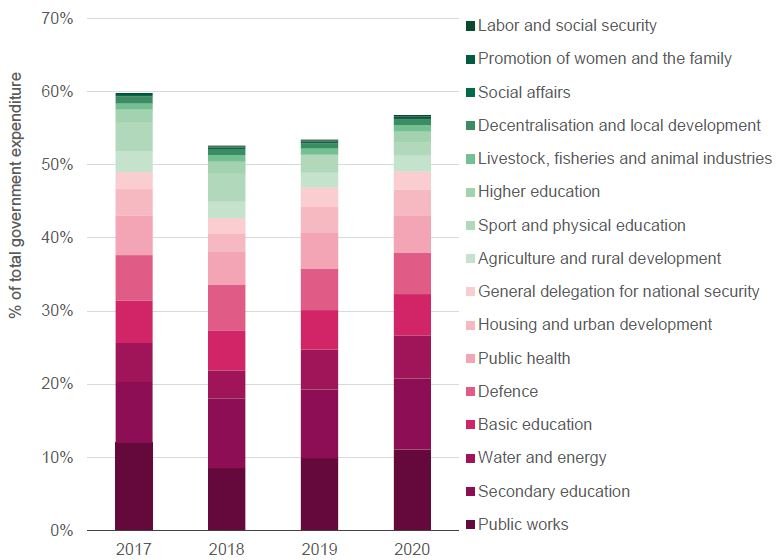
The share of government expenditure allocated to government ministries decreased overall in 2018, with the ministries of Housing and Urban Development, Public Works, and Water and Energy most affected.
Source: Development Initiatives based on Loi de finance 2018, 2019 and 2020, Gouvernement du Cameroun.
Notes: 2020 data is the planned budget for this year, while the data for previous years are the executed budget. Ministry budget allocation figures are proportional to total government expenditure minus debt repayment (excluding interest payments) to conform with international reporting standards (e.g. IMF GFS manual).
International financing landscape
Loans as a large proportion of rising ODA
Official development assistance (ODA) is an increasing resource in Cameroon. Volumes of ODA have grown by 68% over the last 10 years, from US$719 million in 2009 to US$1.2 billion in 2018. Totals peaked in 2017 at US$1.3 billion. Cameroon was the 35th largest ODA recipient in terms of volumes in 2018 (out of 143 recipients of ODA).
A growing proportion of ODA to Cameroon has taken the form of loans – from 17% in 2011 to 51% in 2018 (Figure 4). This is largely due to an increase in non-concessional loans taken by the government to fund infrastructural programmes, which led to a balance of payment issue. As a result, the International Monetary Fund (IMF) increased concessional lending to help stabilise the government’s payment issues. However, most externally financed infrastructure projects have not directly benefited crisis-affected regions (Figure 5). There is also a risk that unsustainable government debt constrains government spending on services that benefit the poor.
Humanitarian and developmental ODA targeting crisis regions
Low development and humanitarian funding to crisis-affected regions continues to be a challenge in Cameroon. This undermines the practical delivery of the OECD DAC HDP nexus recommendation and is a cause of marginalisation. Despite significant increases, humanitarian aid has been insufficient – below US$30 million in each year between 2009 and 2013 before rising because of the Boko Haram insurgency in the Far North and large inflows of refugees from CAR arriving into eastern Cameroon. It remains small relative to total ODA – just 9% of Cameroon’s total ODA in 2018 according to OECD DAC statistics. Funding for the Humanitarian Response Plan (HRP) peaked at US$144.3 million in 2018, [31] representing 45.1% coverage of needs, and declined in 2019 to $130.1 million. [32] Cameroon’s 2018 HRP was the least-funded in sub-Saharan Africa [33] and the 2019 HRP was the least funded in all of Africa. [34]
The data shows that a very low proportion of aggregate developmental ODA is reported as targeting crisis-affected regions compared with non-crisis regions. The central region, which is not crisis-affected and where the capital city Yaoundé is located, received 79.1% of developmental ODA in 2019 (Figure 5). [35] However, this may include nationwide projects, meaning funds are not all necessarily spent in this region (see below for more on data challenges). A very small proportion was directed to the sociopolitical crisis in the Northwest (1.2%) and Southwest (1.8%), which is unsurprising given the constraints international actors face in accessing these areas. [36] A slightly greater proportion was allocated to the marginalised Far North (5.1%), although this is still relatively low and likely to reflect the increase in global financing frameworks targeting this region since 2017, given its importance to the Lake Chad Basin crisis. It is important to note that the proportion of funds allocated to crisis regions differs by donor. The EU, using its own data, reports that 32.5% of EU grants (EU Services plus EU Member States) target crisis regions, and this does not include benefits from nationwide projects. [37] The World Bank reported that its commitments to the northern regions accounted for 40% of its total portfolio in 2016, and its Country Partnership Framework (CPF) for 2017–2021 commits to expand this support further.
Figure 5: Development ODA to regions of Cameroon, 2019
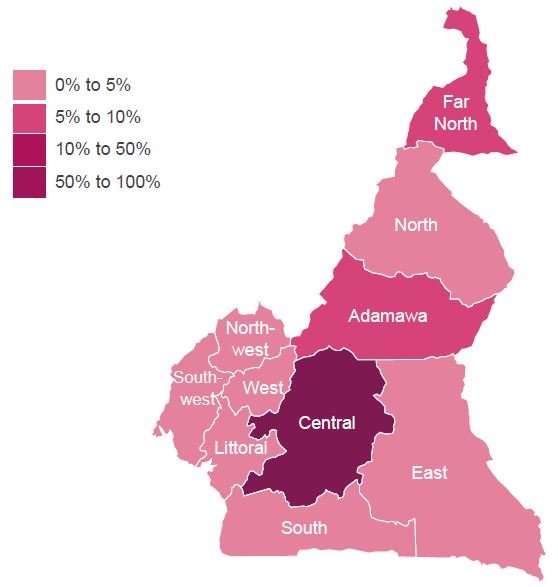
The central region, which is not crisis-affected and where the capital city Yaoundé is located, received 79.1% of developmental ODA in 2019.
Source: Development Initiatives based on International Aid Transparency Initiative (IATI) Registry data.
Note: Total disbursements reported to IATI Registry data by region in 2019 as a proportion of total disbursements reported to IATI Registry data to Cameroon in 2019.
It is difficult to track ODA targeting crisis-affected regions for a variety of reasons. The OECD DAC Creditor Reporting System (CRS) – the most comprehensive data source for financial tracking of ODA – does not currently have a coding system that enables systematic tracking of crisis-focused funding. While donors can specify if ODA is humanitarian or if it targets a particular region, their reporting is likely to be incomplete. In addition, aid channelled to the government and to national programmes may benefit crisis affected regions directly or indirectly, even if a specific crisis-affected region is not the primary focus.
Government data on the allocation of external aid also demonstrates the concentration of funding in non-crisis regions. Figures 6 and 7 show that most external finance to social development and infrastructure was channelled to regions with the major cities and centres of economic development: Littoral, South and Central regions. The crisis-affected regions (East, Adamawa, Northwest, Southwest, North and Far North) received a much smaller proportion.
Figure 6: External disbursements to infrastructure by region, 2017 and 2018
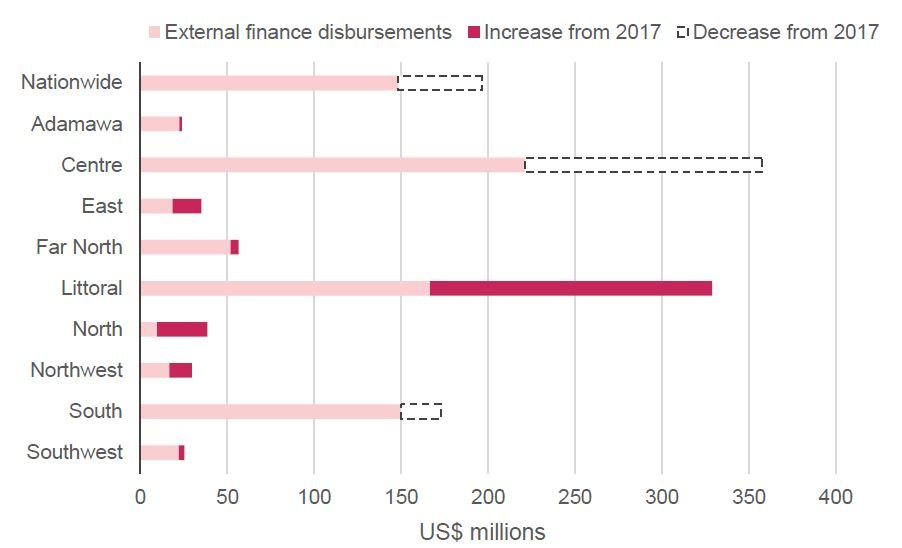
Crisis-affected regions continue to receive the smallest shares of external financing for infrastructure, despite each experiencing an increase in the volume of financing between 2017 and 2018. External infrastructure financing almost doubled to the region of Littoral from 2017 to 2018, whilst the other non-crisis regions of Central and Southwest Cameroon experienced decreases in the volumes received.
Source: Cameroon aid management platform.
Notes: Data in current prices. Data on disbursements to West is not available.
Figure 7: External disbursements to social development by region, 2017 and 2018
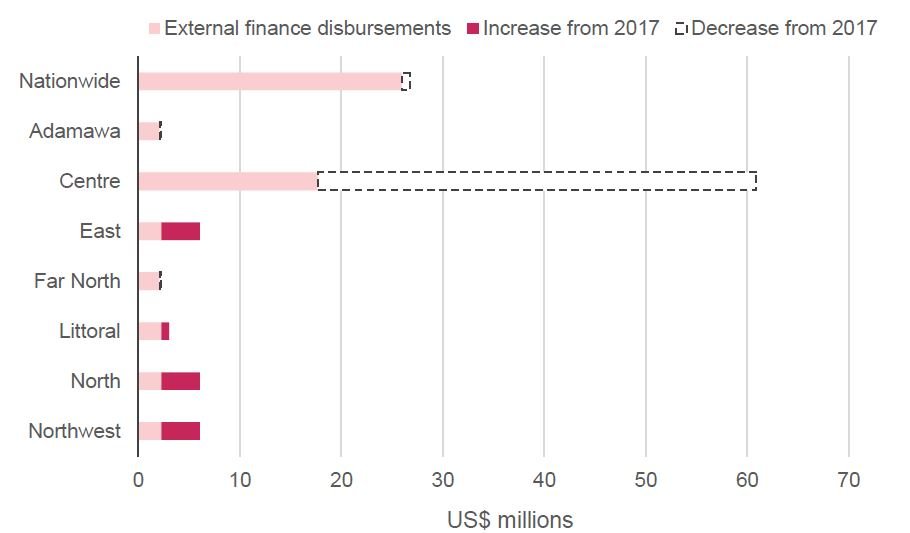
External finance to social development was highly concentrated in the Central region in 2017, although this fell by 59% in 2018. Meanwhile, all other regions experienced an increase in external social development financing; the largest growth was seen by the East, North and Northwest regions − all of which are crisis-affected.
Source: Cameroon aid management platform.
Notes: Data on disbursements to Southwest and South is not available. Data in current prices.
A unique funding landscape
Cameroon’s donor landscape is unique because it is dominated by only a handful of donors, and regional, global and thematic funding instruments play a key role. Cameroon’s largest donors in 2018 were France (29%), IMF (12%), World Bank (11%), Germany (9%) and EU (6%). The UN provided only 2% of Cameroon’s total ODA in 2018 (Figure 8).
Besides France (with historical ties to Cameroon) and Germany (an increasingly important donor over recent years), Cameroon is not a strategic priority for bilateral donors. As a result, bilateral donors have worked through global and multilateral partners and do not have in-country presence. This poses serious challenges for coordination and collective prioritisation. It is also reportedly a result of donors shifting to prioritise humanitarian assistance through UN agencies, as has been the case with the UK, [38] the US [39] and Canada [40] (see ‘ Organisational issues ’ chapter).
In 2020, the World Bank added Cameroon to its list of fragile and conflict-affected countries, [41] which may help it access new development funding dedicated to fragile contexts. Classified as a low-income country by the IMF, Cameroon is eligible to receive no-interest credit from the IMF Extended Credit Facility. It granted concessional loans to Cameroon in May 2020 to support the national response to Covid-19. [42]
Figure 8: Top five donors to Cameroon, 2009−2018
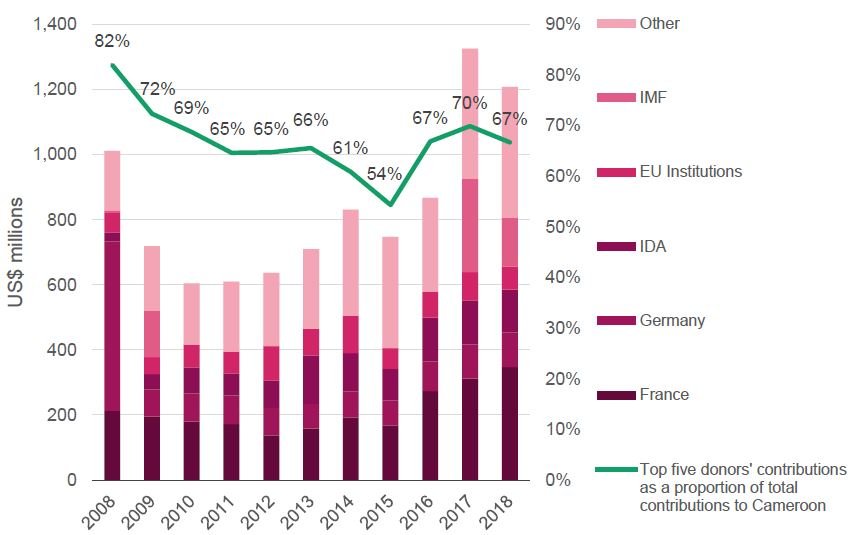
Cameroon’s largest donors in 2018 were France (29%), IMF (12%), World Bank (11%), Germany (9%) and EU (6%). The UN provided only 2% of Cameroon’s total ODA in 2018.
Source: Development Initiatives based on OECD DAC Creditor Reporting System (CRS).
Notes: Data in 2017 constant prices. IDA = International Development Association; IMF = International Monetary Fund (Concessional Trust Funds).
Regional and global programmes and financing mechanisms
Development partners often finance responses to Cameroon’s crises through unique, crisis-focused regional and multilateral funds and programmes. This is due, firstly, to the regional nature of the Lake Chad Basin and CAR crises, for which there has been an effort to develop regional responses. Secondly, donors such as the EU and France have established separate crisis-financing facilities to allow faster decision-making and greater flexibility than would be allowed through normal bilateral channels (see ‘ Financing tools ’ chapter for further discussion).
Financing the Covid-19 response
Figure 9: Total ODA disbursements to Covid-19 as humanitarian assistance and developmental ODA, January–July 2020

Financing for Covid-19 increased month on month (except in May) between March and July 2020.
Source: Development Initiatives based on International Aid Transparency Initiative (IATI) data.
Note: Data in current prices.
Financing for Covid-19 increased month on month (except in May) between March and July 2020 (Figure 9). This was mostly developmental ODA, demonstrating the speed at which development actors responded (in particular the World Bank and IMF).
While this data represents new money, some funding has also been reallocated from existing programmes. It is difficult to have a complete and accurate picture, as financial tracking systems are not set up to capture this and reporting is optional. Nevertheless, country-level data from late September indicated that 15% (US$10 million of US$65 million) of approved or received funding for the Covid-19 response had been redirected from existing programmes. As the data-collection process is ongoing, this is likely not to be a comprehensive figure in terms of scale. Still, it provides an indication of the proportion of funding for the response made available through reprogramming, which is evidence of the flexibility of some development funds.
The proportion of Covid-19- marked ODA as humanitarian assistance has consistently comprised a small proportion of total ODA, reaching 5.9% in July 2020. This demonstrates the slow pace at which funding for the global HRP for Covid-19 has taken place. The response to Covid-19 thus contests earlier perceptions that humanitarian actors can flex and act more quickly than development actors. Conversely, where there is political will to override clunky bureaucratic processes, development actors can access much greater volumes of finance at speed, whereas for humanitarian actors the challenge is not process as much as it is access to finite resources. The largely developmental response to Covid-19 is positive in that it lays the foundation for a more sustainable approach to tackling longer term socioeconomic impacts of the pandemic than is the case for a predominantly humanitarian response.
Whether this development finance takes the most appropriate form is a separate question. Figure 10 shows that most ODA to Covid-19 has taken the form of grants, although in June 2020 70% of total ODA was in the form of loans.
Notes
-
1
The Central African Economic and Monetary Community is made up of six states: Gabon, Cameroon, the Central African Republic (CAR), Chad, the Republic of the Congo and Equatorial Guinea.Return to source text
-
2
UNHCR, 2020. Cameroon Multi-Country Operation Factsheet, May 2020. Available at: https://reliefweb.int/sites/reliefweb.int/files/resources/77406.pdfReturn to source text
-
3
Food Security Information Network, 2020. Global Report on Food Crises. Available at: https://www.fsinplatform.org/sites/default/files/resources/files/GRFC_2020_ONLINE_200420.pdfReturn to source text
-
4
OCHA, 2020. Cameroon Humanitarian Response Plan 2020. Available at: https://reliefweb.int/report/cameroon/cameroon-humanitarian-response-plan-march-2020Return to source text
-
5
UNHCR, 2018. Transitional safety net for Central African refugees. Available at: https://www.unhcr.org/5c98fd437.pdfReturn to source text

